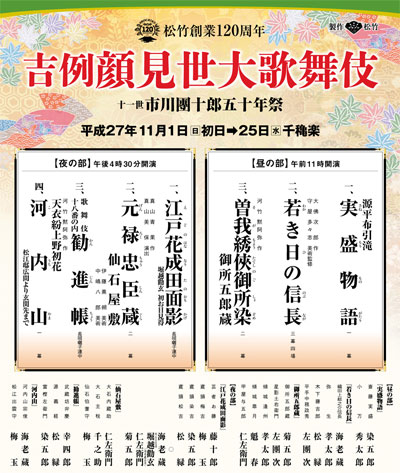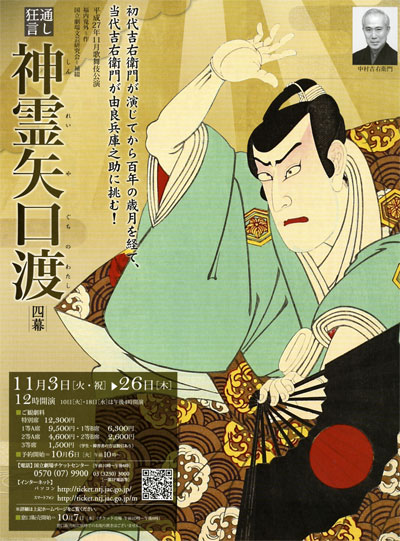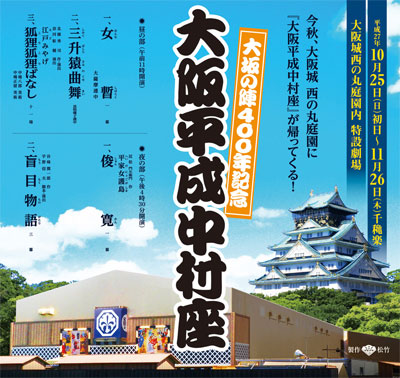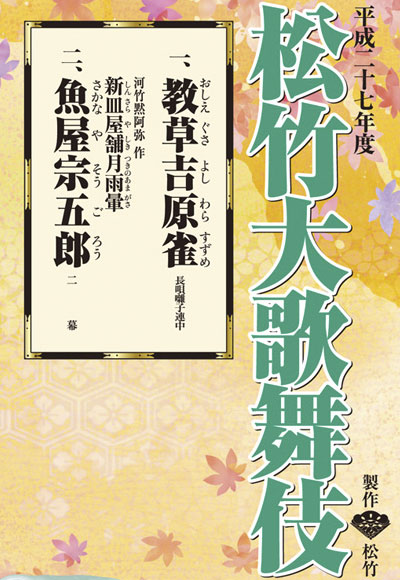| NOVEMBER 2015 |
| Kabukiza (T˘ky˘) |  |
| Dates | 1 ~ 25 November 2015 (Kichirei Kaomise ďkabuki) Annual Festive Face-Showing Grand Kabuki |
| MatinÚe | |
| Evening |
Edo no Hana Narita no Omokage |
| Casting |
Living National Treasure Onoe Kikugor˘, Living National Treasure Sakata T˘jűr˘, Living National Treasure Kataoka Nizaemon, Matsumoto K˘shir˘, Ichikawa Ebiz˘, Kataoka Takatar˘, Nakamura Baigyoku, Nakamura Kaishun, Ichikawa Sadanji, Onoe Sh˘roku, Ichikawa Somegor˘, Kataoka Hidetar˘, Kataoka Ichiz˘, Kawarasaki Gonjűr˘, Ichikawa Unosuke, Ichimura Kakitsu, Band˘ Shűch˘, Nakamura Kikaku, Nakamura Matsue, Ichikawa Kudanji, Band˘ Kametoshi, Sawamura S˘nosuke, Kataoka Matsunosuke, Ichimura Kitsutar˘, Kataoka Sennosuke, Nakamura Kotar˘, ďtani Hirotar˘, ďtani Hiromatsu, Nakamura Umemaru |
| Comments |
Ichikawa Ebiz˘'s son Horikoshi Kangen makes his first stage appearance (omemie). This kaomise commemorates the 50th anniversary of the passing away of Kangen's great-grandfather Ichikawa Danjűr˘ XI, who passed away the 10th of September 1965. Unfortunately this can't be a Naritaya 3-generation event as Kangen's grandfather Ichikawa Danjűr˘ XII passed away the 3rd of February 2013. It was the same for both Ichikawa Danjűr˘ XII and Ichikawa Ebiz˘, who made their omemie after the passing-away of their grandfather.
|
 |
| National Theatre (T˘ky˘) |
| Dates | 3 ~ 26 November 2015 |
| Program |
Shinrei Yaguchi no Watashi |
| Casting |
Living National Treasure Nakamura Kichiemon, Nakamura Shibajaku, Nakamura Kinnosuke, Nakamura Karoku, Nakamura Matagor˘, Nakamura T˘z˘, Nakamura Kash˘, Nakamura Tanenosuke, Arashi Kitsusabur˘, ďtani Keiz˘ |
| Comments |
T˘shi ky˘gen production at the National Theatre of "Shinrei Yaguchi no Watashi" in 4 acts (4 scenes). The zagashira is Living National Treasure Nakamura Kichiemon. The classic "Tonbŕ Sumika" act (also called "Yaguchi no Watashi"), which is still in the Kabuki repertoire, is staged at the end of this program, along with 3 long-forgotten acts! The second act, "Yura Hy˘gonosuke Shin Yashiki", was staged for the last time in July 1915, more than 100 years ago, in T˘ky˘ at the Kabukiza with Nakamura Kichiemon I in the leading role. The two others revived acts are "Yakimochi-zaka" as the opening act and "D˘nen Anjitsu" as the third act.
|
 |
| Dates | 21 November 2015 (Dent˘ Kabuki Hozonkai Kenshű Happy˘kai) Training Recital of the Organization for the Preservation of Kabuki |
| Program |
Zadankai |
| Casting |
Nakamura Yonekichi, Nakamura Kichinosuke, Nakamura Ch˘ichir˘, Nakamura Ch˘zabur˘, Nakamura Ch˘nosuke, Nakamura Kichibŕ, Nakamura Kichijir˘, Nakamura Kichisuke, Nakamura Ky˘yuki, Nakamura Ky˘sumi |
| Comments |
17th Training Recital at the National Theatre produced by the Organization for the Preservation of Kabuki. "Zadankai" (literally "Roundtable Discussion") is a stage speech delivered by Nakamura Kichiemon, Nakamura Shibajaku, Nakamura Kinnosuke, Nakamura Karoku, Nakamura Matagor˘ and Nakamura T˘z˘.
|
| Heisei Nakamuraza (ďsaka) | |
| Dates | 25 October ~ 26 November 2015 |
| MatinÚe |
Shikakubashira Saru no Kusemai |
| Evening | |
| Casting |
Nakamura Kankur˘, Nakamura Shichinosuke, Nakamura Hashinosuke, Nakamura Senjaku, Band˘ Yajűr˘, Kataoka Kamez˘, Band˘ Shingo, Nakamura Tsurumatsu, Nakamura Toranosuke, Nakamura Kunio |
| Comments |
The Heisei Nakamuraza is in ďsaka for the third time. This time, it is a 33-day project, with two different programs. The temporary koshibai look-alike theater is built in the precincts of the ďsaka Castle, in the heart of the Nishi no Maru Park. These performances celebrate the 400th anniversary of the beginning of the Siege of ďsaka, which started in Fall/Winter 2014 (the "Winter Siege" (Fuyu no Jin in Japanese) from November 1614 to January 1615) and ended in Summer 2015 (the summer siege (Natsu no Jin in Japanese) in May and June 1615). The output of this bloody war was the complete destruction of both the ďsaka Castle and the line of Toyotomi Hideyoshi.
|
 |
| Eirakukan (Toyooka) |  |
| Dates | 4 ~ 10 November 2015 (Eirakukan ďkabuki) Eirakukan Grand Kabuki |
| Program |
Seiun no Za (Izumo no Katsura Kogor˘) |
| Casting |
Kataoka Ainosuke, Nakamura Ganjir˘, Kamimura Kichiya, Nakamura Kazutar˘ |
| Comments |
This is the 8th Kabuki program at the Eirakukan, a renovated traditional theater built in the city of Toyooka (prefecture of Hy˘go).
|
| Sh˘chiku Grand Kabuki Tour | |
| Dates | 1 ~ 25 November 2015 (Sh˘chiku ďkabuki) Sh˘chiku Grand Kabuki |
| Program | |
| Casting |
Onoe Kikunosuke, Ichikawa Danz˘, Band˘ Kamesabur˘, Nakamura Baishi, Onoe Matsuya, Onoe Ukon, Nakamura Mantar˘ |
| Comments |
A special Autumn tour sponsored by the Sh˘chiku!
|
 |
|
|||
| Dates | 29 October ~ 3 November 2015 (Band˘ Tamasabur˘ Tokubetsu Buy˘ K˘en) Band˘ Tamasabur˘ Special Dance Performances |
||
| Program |
Keisei |
||
| Casting |
Living National Treasure Band˘ Tamasabur˘ |
||
| Comments |
A special Buy˘ program starring the amazing Living National Treasure onnagata Band˘ Tamasabur˘ in Yamaga at the Yachiyoza, a traditional wooden-built theater. The first item in the program is a k˘j˘.
|
||
| Shinbashi Enbuj˘ (T˘ky˘) |
| Dates | 7 October ~ 25 November 2015 (SűpÔ Kabuki Sekando) Super Kabuki II |
| Program |
ONE PIECE |
| Casting |
Ichikawa Ennosuke, Ichikawa Danshir˘, Ichikawa Ukon, Ichikawa Monnosuke, Ichikawa Omez˘, Ichikawa Emisabur˘, Ichikawa Emiya, Ichikawa Shun'en, Ichikawa En'ya, Ichikawa Juen, Ichikawa K˘tar˘, Band˘ Minosuke, Nakamura Hayato |
| Comments |
A hot topic in Fall 2015: Oda Eiichir˘'s internationally popular manga "ONE PIECE" gets his first Kabuki adaptation by Ichikawa Ennosuke. Technically and artistically speaking, it is not Kabuki but SűpÔ Kabuki Sekando (the second generation of SűpÔ Kabuki), a genre created by Ichikawa Ennosuke III and continued by his nephew Ichikawa Ennosuke IV. Most of the actors are Kabuki actors, with 3 non-Kabuki guest actors : Fukushi Seiji, Kashima Noritoshi and Asano Kazuyuki.
|
 |
|
|
| Contact | Main | Top | Updates | Actors | Plays | Playwrights | Programs | Links | FAQ | Glossary | Chronology | Illustrations | Prints | Characters | Derivatives | Theaters | Coming soon | News |